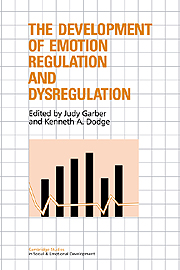1 - Domains of emotion regulation
Published online by Cambridge University Press: 26 March 2010
Summary
For a long time, the regulation of emotion has occupied a prominent place in scientific inquiry. Indeed, Sigmund Freud's (1926/1977) theory of psychosexual development dealt largely with the struggle between internal emotional impulses and attempts by the individual to control or regulate their expression. According to Freud, the control of emotional desires involved their redirection by means of defense mechanisms (e.g., sublimation, reaction formation), and the absence of such regulation results in psychopathology and anxiety. In another tradition, Charles Darwin (1872) spent years trying to understand the expression of emotions in humans and animals. Some of the central issues in both of these authors' studies concern the processes through which emotions are displayed, inhibited, and controlled. Accordingly, a major debate in emotion theory over the years has been over the question of whether emotional experience is a direct outcome of brain activity (e.g., the Cannon theory; see Cannon, 1927) or is mediated and therefore regulated through the cognitive processing of behavioral and autonomic cues (e.g., the James-Lange theory; see James, 1884; Lange & James, 1922). The crux of this debate is whether one construct (emotion) is regulated by another construct (cognition). Hence, the topic of emotion regulation has been a long-standing concern of theorists, even though emotion researchers traditionally have been occupied with defining and measuring emotion and have only recently grappled with regulatory processes.
- Type
- Chapter
- Information
- Publisher: Cambridge University PressPrint publication year: 1991
- 56
- Cited by



